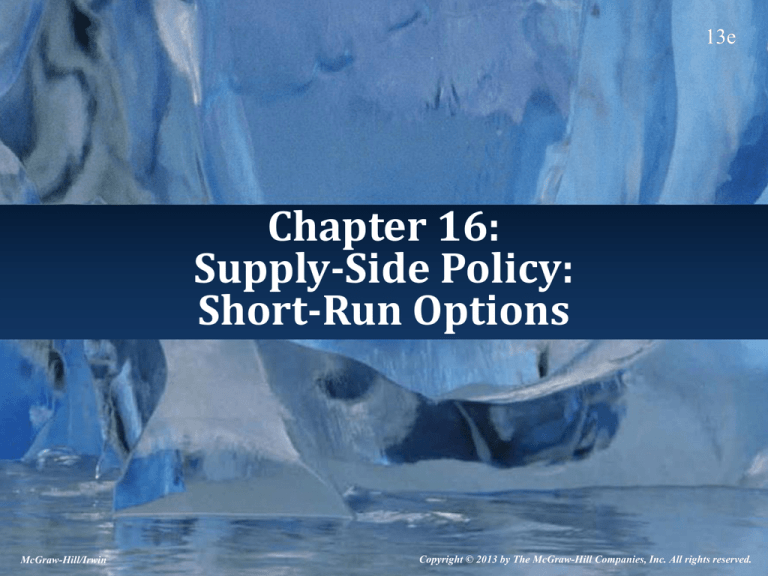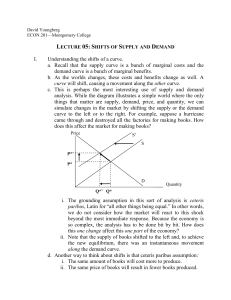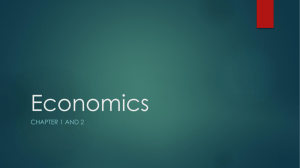
13e
Chapter 16:
Supply-Side Policy:
Short-Run Options
McGraw-Hill/Irwin
Copyright © 2013 by The McGraw-Hill Companies, Inc. All rights reserved.
Supply-Side Policy
• Fiscal and monetary policies focus on the
demand side of the macro economy. These
policies shift the aggregate demand curve.
• Policies that alter the willingness or ability
to supply goods at various price levels will
shift the aggregate supply curve. They are
supply-side policies.
16-2
Learning Objectives
• 16-01. Explain why the short-run AS curve
shifts upward.
• 16-02. Discuss how an unemploymentinflation trade-off arises.
• 16-03. Identify the tools of supply-side
policy.
16-3
Aggregate Supply
• In the 1970s, stagflation occurred.
– Stagflation: the simultaneous occurrence of
substantial unemployment and inflation.
– Shifting AD to “fix” stagflation is not possible.
• Increase AD: unemployment falls and inflation rises.
• Decrease AD: unemployment rises and inflation falls.
• Supply-side policy arose to provide an
answer to stagflation.
16-4
Shape of the AS Curve
• Each policy school in
economics has an
opinion about what
the AS curve looks like.
• Keynesians:
– AS is horizontal.
– An AD shift to the right
in recession increases Q
but does not increase P.
– Inflation becomes a
problem only after AD
shifts past Q*, the
production capacity.
16-5
Shape of the AS Curve
• Each policy school in
economics has an
opinion about what
the AS curve looks like.
• Monetarists:
– Changes in the money
supply affect prices but
not output.
– An AD shift to the right
increases inflation.
– AS is a long-run
concept and is vertical.
16-6
Shape of the AS Curve
• Each policy school in
economics has an
opinion about what the
AS curve looks like.
• Hybrid version:
– Most economists now
see an AS curve with an
upward slope that
increases near full
employment.
– Inflation accelerates in
that region of the curve
as AD shifts right.
16-7
Impact of the Hybrid AS Curve
• Shifts of AD affect both prices and output.
• Outcomes of fiscal and monetary policy
depend on how close the economy is to full
employment.
• The closer we are, the greater the risk that
fiscal or monetary stimulus will spill over
into inflation.
16-8
Inflation-Unemployment Trade-Off
• The message of the upward-sloping AS
curve is that demand-side policies alone can
never succeed completely; they will always
cause some unwanted inflation or
unemployment.
– There is an inflation-unemployment trade-off,
which is expressed in the Phillips curve.
16-9
The Phillips Curve Trade-Off
• As the economy moves from point A to B to C (left picture),
the inflation-unemployment trade-off shifts from point a to b
to c (right picture) on the Phillips curve.
16-10
The Inflationary Flashpoint
• The upward-sloped AS
curve has a point at
which inflation rockets
upward as the decrease
in unemployment slows.
– It is called the inflationary
flashpoint: the output at
which inflationary
pressures intensify; the
point on the AS curve
where slope increases
sharply.
16-11
Shifts of the AS Curve
• Rightward shift of AS:
– Good news! Reduces
unemployment and
inflation at the same time.
– Also increases output.
– Shifting AD cannot do
this.
• Leftward shift of AS:
– Bad news! Both
unemployment and
inflation increase, and
output decreases.
16-12
The Misery Index
• Misery index: a simple sum of the inflation
and unemployment rates.
– If AS shifts right, both elements decrease and
the misery index falls sharply.
– If AS shifts left, both elements increase and the
misery index rises sharply.
16-13
What Shifts the AS Curve?
• Shifting AS right:
– Policies that provide incentives for suppliers to
increase production.
•
•
•
•
•
Tax incentives for saving, investment, and work.
Human capital investment.
Deregulation.
Trade liberalization.
Infrastructure development.
16-14
What Shifts the AS Curve?
• Shifting AS left:
– Policies that provide disincentives for suppliers
to increase production.
•
•
•
•
•
Tax increases for saving, investment, and work.
Deteriorating human capital investment.
Excessive, costly regulation.
Trade restrictions.
Decaying infrastructure.
– Negative external shocks, such as natural
disasters and war.
16-15
Tax Incentives
• Keynesians cut taxes to increase AD.
• Supply-siders note that high tax rates
destroy the incentive to work and produce,
which ends up reducing output.
• Low tax rates encourage people to earn
more because more ends up in disposable
income and less goes to the government.
16-16
Tax Incentives
• Supply-siders emphasize a reduction in
marginal tax rates for both workers and
firms.
– Marginal tax rate: the tax rate imposed on the
latest earned (marginal) dollar of income.
– High marginal tax rates provide a disincentive
to
• Earn more.
• Start or expand a business.
• Increase investment spending.
16-17
Tax Incentives
• A reduction in marginal tax rates will shift
AS to the right.
• On the other hand, a tax rebate (one-time
tax refund) adds to disposable income but
does not affect the marginal tax rate, so AS
does not shift.
16-18
Savings Incentives
• Keynesians treat saving as a leakage to the
circular flow, because they emphasize
spending.
• Supply-siders emphasize the importance of
saving for financing more investment and
economic growth.
– They favor tax incentives that encourage saving
and greater tax incentives for investment.
16-19
Investment Incentives
• Supply-siders advocate tax incentives for
investment:
– Reduced taxes on capital gains and dividends.
– Larger capital expensing of new investment.
• The goal is to expand investment spending,
which increases the capacity to produce.
This will shift AS to the right.
16-20
Human Capital Investment
• Human capital: the knowledge and skills
possessed by the workforce.
• Supply-siders encourage investments in
human capital to provide the knowledge
and skills needed to reduce structural
unemployment.
– This can be done by providing tax credits to
employers who offer more worker training.
16-21
Other Human Capital Incentives
• Supply-siders want to increase human capital
by expanding and improving the educational
system.
• Affirmative action programs are designed to
reduce discriminatory barriers, which will shift
AS to the right.
• Transfer payments can become excessive and
provide a disincentive for recipients to take a
job. Welfare reforms in 1996 had a positive
supply-side impact and kept basic welfare
programs intact.
16-22
Deregulation
• When government sets rules that directly
affect employment and production
decisions, it affects the AS curve.
– Excessive regulation is costly to producers and
will shift AS to the left.
– Decreased regulation (or deregulation) reduces
costs for producers and will shift AS to the right.
16-23
Deregulation
• Government interventions that have good
reasons for existing but shift AS to the left by
increasing costs to producers.
–
–
–
–
–
–
Minimum wage.
Mandatory benefits.
Occupational health and safety.
Transportation costs.
Food and drug standards.
Environmental protection.
• Supply-siders contend that regulatory costs are
now too high.
16-24
Easing Trade Barriers
• When production costs rise, AS shifts left.
– Tariffs (taxes on imported goods) make input costs
higher.
– Immigration restrictions make it more difficult to
overcome skill shortages.
• By advocating the reduction of tariffs on inputs
and improvement in the flow of immigrant
workers, supply-siders note that production
costs fall and AS shifts right.
16-25
Infrastructure Development
• Infrastructure: the transportation,
communications, education, judicial, and
other institutional systems that facilitate
market exchanges.
– Improving these institutional structures makes
commerce flow easier and therefore reduces
costs.
– Reducing costs will cause the AS curve to shift
right.
16-26
Adverse Supply-Side Policies
• The following policies shift AS to the left:
– Higher marginal tax rates for individuals and
businesses.
– Increased taxes on saving and investment.
– Letting infrastructure deteriorate.
– Increased government regulation.
– Increased trade barriers.
• When AS shifts left, output decreases,
unemployment rises, and inflation increases.
16-27








